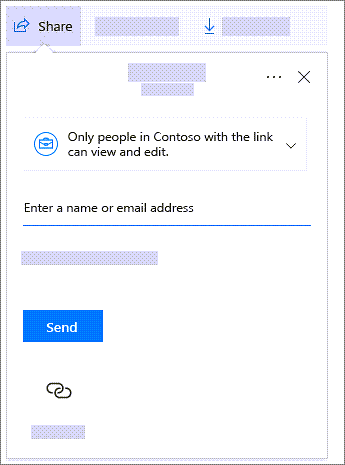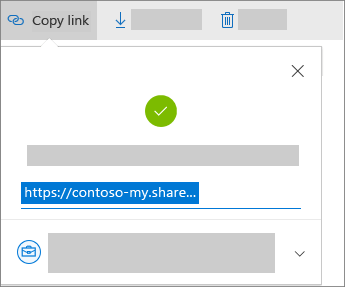The files you store on a SharePoint site are usually available to everyone with permissions to the site, but you may want to share specific files or folders with people who don't otherwise have access to the site. When you share files and folders, you can decide whether to let people edit or just view them. You can see who a SharePoint file is shared with, and stop sharing SharePoint files or folders, or change permissions, at any time.
(Want to share the entire site?)
Tip: Check out these YouTube videos from Microsoft Creators to learn more about working in SharePoint!
Share a file or folder
Here's how you share files or folders in SharePoint:
-
Select the file or folder you want to share, and then select Share.

-
(Optional) Select the dropdown list to change the type of link. The Details pane opens, where you can change who can access the link and whether people can edit the item you're sharing.
Options for Who would you like this link to work for (options vary based on admin settings):
-
Anyone gives access to anyone who receives this link, whether they receive it directly from you or forwarded from someone else. This may include people outside of your organization.
Note: This option is not available in SharePoint Server 2019.
-
People in <Your Organization> gives anyone in your organization who has the link access to the file, whether they receive it directly from you or forwarded from someone else.
-
People with existing access can be used by people who already have access to the document or folder. Use this if you just want to send a link to somebody who already has access.
-
Specific people gives access only to the people you specify, although other people may already have access. If people forward the sharing invitation, only people who already have access to the item will be able to use the link.
Note: If a sharing option has been greyed out, your organization's admins may have restricted them. For example, they may choose to disable the Anyone option to prevent usable links being forwarded to others.
By default, Allow editing is turned on. If you want people to only view your files, uncheck the check box.
When you're done, select Apply.
-
-
Enter the names of the people you want to share with and a message, if you want.
-
When you're ready to send the link, select Send.
Note: When sharing a file, if you select the Outlook option, this only allows you to include a link to the file in the email message. If you want to attach the actual file, you must download a local copy from SharePoint, then attach the file to the email.
Get a link to a file or folder that you can copy
Another way to share is to get a link to a file or folder that you can copy and paste in a text message or on a website. People you share these links with can also forward your link to others.
-
In SharePoint, select Copy link. The link is automatically copied to your clipboard.

-
(Optional) Select the dropdown list to change the type of link. The Details pane opens, where you can change who can access the link and whether people can edit the item you're sharing.
Options for Who would you like this link to work for (options vary based on admin settings):
-
Anyone gives access to anyone who receives this link, whether they receive it directly from you or forwarded from someone else. This may include people outside of your organization.
-
People in <Your Organization> gives anyone in your organization who has the link access to the file, whether they receive it directly from you or forwarded from someone else.
-
People with existing access can be used by people who already have access to the document or folder. It does not change the permissions on the item. Use this if you just want to send a link to somebody who already has access.
-
Specific people gives access only to the people you specify, although other people may already have access. If people forward the sharing invitation, only people who already have access to the item will be able to use the link.
By default, Allow editing is turned on. If you want people to only view your files, uncheck the check box. This can be further restricted by selecting the option to Block download, which means they cannot save a local copy.
When you're done, select Apply.
-
-
Paste the link (Ctrl+V) wherever you want, such as a text message or on a website.
Notes:
-
The permission granted by a sharing link lasts only as long as the link exists. For example, when a link is disabled, access is revoked (though people may still have access to the file via other means).
-
When Allow editing is selected: After they sign in, people in your organization can edit, copy, or download the files. When Allow editing isn't selected, people in your organization can view, and may be able to copy or download the files.
-
Site administrators can restrict sharing so that only owners can share files and sites.
-
If site administrators have not restricted sharing to site owners, any person with Edit permissions to a file or folder can share that file or folder with others by selecting Share or Copy link. People who don't have edit permissions can use Copy link to get a link that will work for people who already have permissions to the file or folder.
-
The option to create or open "Anyone" links to .aspx pages is not supported.
I have another question
To learn how to share with a group, see Share files and folders with Outlook groups.
Didn't find your answer here? Try posting your question in the Microsoft community.
No comments:
Post a Comment